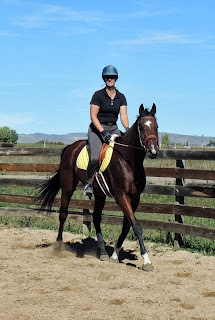 |
| Meet Oberon, or "Obie" for short |
The most important things with regard to a horse's body mechanics while riding is that he is balanced, stepping well under himself, and pushing from his haunches. I never aim for the horse's head to be in a certain position, because if he is using his haunches correctly his back will lift, and his head will naturally fall into the position where he is most comfortable and balanced. By not interfering with where he puts his head, you have a good barometer for how he is using his haunches.
 |
| Notice how during this lengthening and stretch his haunches are rotated
somewhat to allow his hind foot to step well under his hip joint. This rotation is what causes his back to lift, and his head to stretch down. |
When a horse is first learning to move with a rider he carries approximately 60% of his weight on his forehand, leaving 40% for his hind end. You can see this in the height of his withers compared to the height of his buns. Imagine a teeter totter with your horse's forehand and haunches on each end:
 |
| Green horse weight distribution at the trot - approximately 60% on the forehand, 40% haunches |
The horse's engine is really his haunches, and so as the horse moves up the levels in any discipline, the goal is to have him carry more and more weight on his engine. So for front/hind you would go from 60/40 to 50/50.
 |
| Approximately 50/50, this is definitely a more level topline, comparing height of withers to haunches. This photo has lines drawn in to show how cantering positively affects his balance, showing that he is putting more weight on his hind end for more thrust forward, since the haunches are lowered as they work as the horse's engine. Because of this he is also showing more reach with his hind leg underneath his body. Canter work is excellent for getting the horse to use his buns and lift his back, just because of the rolling nature of the gait. |
Then from 50/50 to 40/60 with the haunches weighted more heavily. Depending on how far into dressage (the word "dressage' means "training") the horse goes, the airs above ground show the horse carrying his weight exclusively on his hind end, plus leaping in place using just his haunches. The process of asking or reminding the horse to incrementally shift more weight to his haunches is called a "half-halt".
 |
| This photo shows Obie not quite at 40/60, but definitely more "uphill". It has the line drawn to show how he is carrying more weight on his haunches than his forehand. He is trotting in this photo |
The balance of weight front to back is often referred to as his "frame", his level of "collection", or how he is carrying himself. If not constricted, the horse's head position is an indicator of how he is using his hind end, since he will put his head wherever it needs to be to keep himself comfortable and balanced.
Often people will try to "set" the horse's head in a certain place without addressing how he is traveling or using his haunches. In this way you may achieve a certain head position, because he can put his head someplace without using his buns. However, this causes tension, jaw pain, flexion at the 3rd cervical vertebrae resulting in hypertrophy or overdevelopment of the neck muscles, sore back, trachea or air-pipe restriction, any number of problems that will manifest themselves eventually as soundness issues. There are many terms for this artificial headset. One term is "false collection". The horse's head position may appear to show collection, but he's not actually carrying more weight on his haunches so it's a false collection. Other terms to describe this headset is "in the bridle" or "behind the bit".
This photo shows false collection, and the artificial headset Obie had been taught before his current owner got him.
 |
| An example of "false collection", or "in the bridle" or "behind the bit", where he is not engaging his haunches or stepping underneath himself with his hind leg. In fact you can see his hind legs trailing behind his haunches. His head is behind the vertical, and his neck is flexed at the 3rd vertebrae rather than at the poll. |
These photos are of Obie with a comfortable, relaxed head position. He has a history of curling his neck, flexing at the 3rd cervical vertebrae rather than at the poll to evade the bit, so these photos show great progress with his relaxation level.
 |
| comfortable, relaxed head position with his face in front of the vertical |
 |
| Note how well he steps under himself with his hind legs when he can stretch and reach forward with his head |
 |
| This photo shows his head in a relaxed position, face in front of the vertical, stepping well underneath himself with his hind leg, and balanced front to back as shown by the parallel angles of his cannon bones. |
 |
| Not to be overkill, but this is an example of some of the physics I see when I look at a horse and rider. Parallel lines for opposite pairs of legs, face slightly in front of the vertical, straight line from the bit through the reins to the rider's elbow, a straight vertical alignment of the rider's ear, shoulder, hip, and heel. There are many other things I look for as well, but this is an abbreviated example with a lot of lines! |
An interesting article on the consequences of a hyperflexed headset and how it affects a horse's breathing and bloodflow.
http://www.thehorse.com/articles/29302/artificial-head-neck-positions-effects-on-horses-breathing



























































